
User manual of ELP AC Servo
www.leadshine.com
1
User Manual Of ELP AC Servo
Ver1.35

User manual of ELP AC Servo
www.leadshine.com
2
Introduction
Thanks for purchasing Leadshine ELP-series AC servo drivers, this instruction manual
provides knowledge and attention for using this driver.
Contact tech@leadshine.com if you need more technical service .
Incorrect operation may cause unexpected accident, please read this manual carefully
before using product.
We reserve the right to modify equipment and documentation without prior notice.
We won’t undertake any responsibility with customer’s any modification of product, and the
warranty of product will be cancel at the same time.
Safety Items
ELP Series servo drive, should be mounted in cover type control box during operating. The
mounting of drive, wiring and motor should be under the regulations of EN 61800-5-1.
Safety items indicate a potential for personal injury or equipment damage if the recommended
precautions and safe operating practices are not followed.
The following safety-alert symbols are used on the drive and in the documentation:
Indicates great possibility of death or serious injury
!
Caution
Indicates something that must be done.
!
Warning
Indicates something that must not be done.
Indicates dangerous voltage.
Indicates do not touch hot heat sink when power on.
Protective Earth
Safety precautions
!
Warning
Warning
The design and manufacture of product doesn’t use in mechanic and system which have a threat
to operator.
The safety protection must be provided in design and manufacture when using this product to
prevent incorrect operation or abnormal accident.
Acceptance
!
Caution
Caution
The product which is damaged or have fault is forbidden to use.

User manual of ELP AC Servo
www.leadshine.com
3
Transportation
!
Caution
Caution
The storage and transportation must be in normal condition.
Don’t stack too high, prevent falling.
The product should be packaged properly in transportation,
Don’t hold the product by the cable, motor shaft or encoder while transporting it.
The product can’t undertake external force and shock.
Installation
!
Caution
Caution
Servo Driver and Servo Motor:
Don’t install them on inflammable substance or near it to preventing fire hazard.
Avoid vibration, prohibit direct impact.
Don’t install the product while the product is damaged or incomplete.
Servo Driver:
Must install in control cabinet with sufficient safeguarding grade.
Must reserve sufficient gap with the other equipment.
Must keep good cooling condition.
Avoid dust, corrosive gas, conducting object, fluid and inflammable ,explosive object from
invading.
Servo Motor:
Installation must be steady, prevent drop from vibrating.
Prevent fluid from invading to damage motor and encoder.
Prohibit knocking the motor and shaft, avoid damaging encoder.
The motor shaft can’t bear the load beyond the limits.
Wiring
!
Warning
Warning
The workers of participation in wiring or checking must possess sufficient ability do this job.
The wiring and check must be going with power off after 10 minutes
Ground the earth terminal of the motor and driver without fail.
The wiring should be connected after servo driver and servo motor installed correctly
After correctly connecting cables, insulate the live parts with insulator.
!
Caution
Caution
The wiring must be connected correctly and steadily, otherwise servo motor may run incorrectly,
or damage the equipment .
Servo motor U, V, W terminal should be connected correctly , it is forbidden to connect them
directly to AC power.
We mustn’t connect capacitors ,inductors or filters between servo motor and servo driver .
The wire and temperature-resistant object must not be close to radiator of servo driver and
motor.
The freewheel diode which connect in parallel to output signal DC relay mustn’t connect
reversely.

User manual of ELP AC Servo
www.leadshine.com
4
Debugging and running
!
Caution
Caution
Make sure the servo driver and servo motor installed properly before power on, fixed steadily,
power voltage and wiring correctly.
The first time of debugging should be run without loaded, debugging with load can be done
after confirming parameter setting correctly, to prevent mechanical damage because of error
operation.
Using
!
Caution
Caution
Install a emergency stop protection circuit externally, the protection can stop running
immediately to prevent accident happened and the power can be cut off immediately.
The run signal must be cut off before resetting alarm signal, just to prevent restarting suddenly.
The servo driver must be matched with specified motor.
Don’t power on and off servo system frequently, just to prevent equipment damaged.
Forbidden to modify servo system.
Fault Processing
!
Warning
Warning
T he high voltage also will contain in several minutes even if the servo driver is powered off,
please don’t touch terminal strip or separate the wiring.
The workers of participation in wiring or checking must possess sufficient ability do this job.
!
Caution
Caution
The reason of fault must be figured out after alarm occurs, reset alarm signal before restart.
Keep away from machine, because of restart suddenly if the driver is powered on again after
momentary interruption(the design of the machine should be assured to avoid danger when
restart occurs)

User manual of ELP AC Servo
www.leadshine.com
5
Table of Contents
Introduction ......................................................................................................................................... 2
ELP series function guidance ...................................................................................................... 8
Chapter 1 Introduction ........................................................................................................................ 9
1.1 Product Introduction ............................................................................................................. 9
1.2 Inspection of product ............................................................................................................ 9
Chapter 2 Product Specification ....................................................................................................... 10
2.1 Driver Technical Specification ............................................................................................ 10
2.2 Accessory selection ............................................................................................................. 11
Chapter 3 Installation ........................................................................................................................ 12
3.1 Storage and Installation Circumstance ................................................................................ 12
3.2 Servo Driver Installation ..................................................................................................... 12
3.3 Servo Motor Installation ..................................................................................................... 13
Chapter 4 Wiring ............................................................................................................................... 14
4.1 Wiring ................................................................................................................................. 14
4.1.1 Wire Gauge .............................................................................................................. 14
4.1.2 Position Control Mode ............................................................................................. 16
4.1.3 Torque /Velocity Control Mode ................................................................................ 17
4.2 Driver Terminals Function .................................................................................................. 18
4.2.1 Control Signal Port-CN1 Terminal........................................................................... 18
4.2.2 Encoder Input Port-CN2 Terminal ........................................................................... 19
4.2.3 RS232/RS485 Communication Port......................................................................... 19
4.2.4 USB Communication Port........................................................................................ 20
4.2.5 Power Port ................................................................................................................ 20
4.3 I/O Interface Principle ......................................................................................................... 21
4.3.1 Switch Input Interface .............................................................................................. 21
4.3.2 Switch Output Interface ........................................................................................... 23
4.3.3 Pulse Input Interface ................................................................................................ 25
4.3.4 Analog Value Input Interface.................................................................................... 27
4.3.5 Servo Motor Encoder Input Interface....................................................................... 28
Chapter 5 Parameter .......................................................................................................................... 29
5.1 Parameter List ..................................................................................................................... 29
5.2 Parameter Function ............................................................................................................. 37
5.2.1【Class 0】Basic Setting .......................................................................................... 37
5.2.2【Class 1】Gain Adjust ............................................................................................ 43
5.2.3【Class 2】Vibration Suppression............................................................................ 48
5.2.4【Class 3】Velocity/ Torque Control ....................................................................... 51
5.2.5【Class 4】I/F Monitor Setting ................................................................................ 58
5.2.6【Class 5】Extended Setup ...................................................................................... 66
5.2.7【Class 6】Special Setup ......................................................................................... 72
5.2.7【Class B】Status Information ................................................................................. 74
Chapter 6 Alarm and Processing ....................................................................................................... 79
6.1 Alarm List ........................................................................................................................... 79
6.2 Alarm Processing Method ................................................................................................... 80
6.3 Alarm clear .......................................................................................................................... 87
Chapter 7 Display and Operation ...................................................................................................... 88
7.1 Introduction ......................................................................................................................... 88
7.2 Panel Display and Operation............................................................................................... 89
7.2.1 Panel Operation Flow Figure ................................................................................... 89
7.2.2 Driver Operating Data Monitor ................................................................................ 89
7.2.3 Auxiliary Function ................................................................................................... 92
7.2.4 Saving parameter...................................................................................................... 93
7.2.5 Abnormal Alarm ....................................................................................................... 94
7.3 Trial Run ............................................................................................................................. 94
7.3.1 Inspection Before trial Run ...................................................................................... 94
7.3.2 Timing chart on power-up ........................................................................................ 95

User manual of ELP AC Servo
www.leadshine.com
6
7.3.3 Timing chart on fault ................................................................................................ 95
7.3.4 Holding brake ........................................................................................................... 95
7.3.5 Trial Run Jog Control ............................................................................................... 96
Chapter 8 Application Case............................................................................................................... 97
8.1 Position Control .................................................................................................................. 97
8.1.1 Process of command pulse input ............................................................................ 100
8.1.2 Electronic gear function ......................................................................................... 101
8.1.3 Position command filter ......................................................................................... 102
8.1.4 Motor encoder pulse output ................................................................................... 102
8.1.5 Position complete output (INP) .............................................................................. 103
8.2 Velocity Control ................................................................................................................ 104
8.2.1 Velocity control by analog speed command ........................................................... 107
8.2.2 Velocity control by internal speed command ......................................................... 109
8.2.3 Speed command acceleration and deceleration ...................................................... 112
8.2.4 Attained Speed signal AT-SPEED output ............................................................... 113
8.2.5 Speed coincidence output (V-COIN) ..................................................................... 113
8.2.6 Speed zero clamp (ZEROSPD) .............................................................................. 114
8.3 Torque Control .................................................................................................................. 115
8.3.1 Analog torque command input ............................................................................... 117
8.3.2 Torque limit function .............................................................................................. 118
8.4 Inertia ratio identification.................................................................................................. 119
8.4.1 On-line inertia ratio identification .......................................................................... 119
8.4.2 Off-line inertia ratio identification ......................................................................... 119
8.5 Vibration Suppression ....................................................................................................... 119
8.6 Third gain switching ......................................................................................................... 121
8.7 Friction torque compensation............................................................................................ 122
8.8 Regenerative resister setting ............................................................................................. 123
8.9 Security Features ............................................................................................................... 123
8.9.1 Speed limit ............................................................................................................. 123
8.9.2 Torque limit (TL-SEL) ........................................................................................... 124
8.10 Multi-turn absolute encoder ............................................................................................ 124
8.10.1 Parameters setting ................................................................................................ 124
8.10.2 Read absolute position ......................................................................................... 125
8.10.3 Alarm.................................................................................................................... 126
8.11 Other functions ................................................................................................................ 127
8.11.1 Zero speed output(ZSP) .................................................................................. 127
8.11.2 Position deviation cleared(CL) ....................................................................... 128
8.11.3 Position setup unit select ...................................................................................... 128
Chapter 9 Pr-Mode function ........................................................................................................... 129
9.1 Overview ........................................................................................................................... 129
9.1.1 Main function ......................................................................................................... 129
9.1.2 Installation wiring .................................................................................................. 130
9.2 Pr-Mode Parameters .......................................................................................................... 132
9.2.1 8th parameters specification ................................................................................... 132
9.2.2 9th parameters specification ................................................................................... 133
9.3 Pr-Mode motion control .................................................................................................... 134
9.3.1 Homing .................................................................................................................. 134
9.3.2 Path Motion ............................................................................................................ 136
9.3.3 Position limit, JOG and E-stop function. ............................................................... 139
9.4 Trigger method of Pr-Mode .............................................................................................. 140
9.4.1 Configuration software operation .......................................................................... 140
9.4.2 IO digital signal Trigger ......................................................................................... 142
9.4.3 RS485 Communication control mode .................................................................... 144
9.4.4 Fixed trigger method .............................................................................................. 147
9.4.5 Immediately trigger method ................................................................................... 148
9.5 Operation case ................................................................................................................... 149
9.5.1 IO trigger case ........................................................................................................ 149

User manual of ELP AC Servo
www.leadshine.com
7
9.5.2 RS485 communication case ................................................................................... 152
Chapter 10 Order Guidance ............................................................................................................ 158
10.1 Capacity Selection .......................................................................................................... 158
10.2 Electronic Gear Ratio ...................................................................................................... 158
Appendix ......................................................................................................................................... 159
A、Modbus Communication .................................................................................................. 159
A.1 Wiring....................................................................................................................... 159
A.2 Parameters and interface for communication ........................................................... 159
A.3 Modbus Protocol ...................................................................................................... 160
A.4 RS485 common problems and solutions .................................................................. 163
Contact us ....................................................................................................................................... 165

User manual of ELP AC Servo
www.leadshine.com
8
ELP series function guidance
NO
Function
Details
Section index
1
Position control
Position control parameter specification,
guidance
8.1 Position control
2
Velocity control
Velocity control parameter specification,
guidance
6.2 Velocity control
3
Torque control
Torque control parameter specification,
guidance
6.3 Torque control
4
Encoder
supported
5000lines、17bit、23bit encoder
5
Auxiliary
Function
JOG、parameter initialization、Soft Reset、
inertia ratio identification etc
7.2.3 Auxiliary Function
6
Vibration
Suppression
It can suppress torque oscillation caused
by too high rigidity
8.5 Vibration
Suppression
7
Inertia ratio
identification
The inertia of the load can be accurately
identified by a simple trial run
6.4 Inertia ratio
identification
8
Electronic gear
function
A certain range of electronic gear ratio can
be set
8.1.2 Electronic gear
function
9
Position command
filter
FIR filter and command smoothing filter
are used to smooth the position command
6.1.3 Position command
filter
10
Acceleration and
Deceleration
Set the speed command acceleration and
deceleration
6.2.3 Speed command
acceleration and
deceleration
11
Third gain
switching
An additional third gain is added to allow
faster positioning by switching between
the first and second gain
6.6 Third gain switching
12
Friction torque
compensation
The friction torque and gravity torque are
compensated for the load.
6.7 Friction torque
compensation
13
Alarm processing
method
6.2 Alarm Processing
Method
14
IO interface
principle
IO input and output functions and each
function can be freely configured to any
physical IO port, Six IO outputs are
available for master station operation
through parameter setting
4.3 IO interface
principle
15
Trial run
Directly through the servo drive panel or
PC can achieve servo motor operation
7.3 Trial run
16
Torque limit
8.9.2 Torque limit
17
Speed limit
8.9.1 Speed limit
18
Regenerative
resister setting
Support internal brake resistance and
external brake resistance, match the
resistance through parameter setting
6.8 Regenerative resister
setting
19
Driver Operating
Data Monitor
Driver operating data monitor
7.2.2 Driver Operating
Data Monitor
20
Alarm and
Processing
A variety of alarm code output to protect
the servo driver security
Chapter 6 Alarm and
Processing
21
Multi-turn
absolute encoder
The driver use the memory position of the
motor with multi-turn absolute encoder to
realize the function of not losing absolute
position after restart power supply
8.10 Multi-turn absolute
encoder

User manual of ELP AC Servo
www.leadshine.com
9
Chapter 1 Introduction
1.1 Product Introduction
ELP/ELM Series AC servo products are high performance AC digital servo which is designed
for position/velocity/torque high accurate control , power range up to 2kw ,which can provide a
perfect solution for different applications, performance with easy tuning process .
Combined with abundant features like MFC, vibration suppression, Multi - mode filter function
etc, and with high resolution encoder up to 23bit , it can provide machines a intelligent
performance.
1.2 Inspection of product
1. You must check the following thing before using the products :
a. Check if the product is damaged or not during transportation.
b. Check if the servo drive & motor are complete or not.
c. Check the packing list if the accessories are complete or not.
2. Type meaning
a. ELP series servo driver
ELP-D 2000 Z
① ② ③ ④
NO
Details
①
Series Num ELP:Servo drive series
②
Command source D:Stand version RS:RS485 EC:EtherCAT
③
Power 0400: 400W 0750: 750W 1000:1000W
1500: 1500W 2000: 2000W
④
Encoder Z: Serial encoder
Model:ELP-D2000Z
Main power input : 3PH 200VAC – 240VAC, 10.5A,50/60Hz
Control power input : 1PH 200VAC – 240VAC, 1A,50/60Hz
Output (UVW):0 -240V,10.5A, 0 - 2500Hz
S/N:38AA1158200001MS10
AC Servo Drive
China Leadshine Technology Co.Ltd
www.leadshine.com
Model name
Input voltage,current,frequency
Barcode
Website
Output voltage,current,frequency
b. Servo motor type
The ELP series AC servo driver can be matched with a variety of domestic and foreign servo motor.
3. Accessory list
1. User manual
2. Power connector
3. Control signal terminal CN1 (44 pin)

User manual of ELP AC Servo
www.leadshine.com
10
Chapter 2 Product Specification
!
Warning
Notice
Servo driver must be matched with relevant servo motor, this manual describes Leadshine ELP series servo motor.
Contact tech@leadshine.com if you need more technical service .
2.1 Driver Technical Specification
Table 2.1 Driver Specification A
Parameter
ELP-*0400Z
ELP-*0750Z
ELP-*1000Z
ELP-*1500Z
ELP-*2000Z
Rated output power
400W
750W
1KW
1.5KW
2KW
Rated output current
3.5
5.5
7
9.5
12
Max output current
8.5
16
21
28.5
36
Main power
Control power
Single phase 220V
-15%~+10% 50/60HZ
Single phase /Three phase 220V
-15%~+10% 50/60HZ
Control mode
IGBT SVPWM sinusoidal wave control
Feedback mode
17bit single-turn incremental encoder/23bit multi-turn absolute encoder
Input pulse
0-500kHZ,5V differential input
Adjust speed ratio
6000:1
Position bandwidth
200HZ
Electronic gear ratio
1~32767/1~32767
Analog input
-10~10Vdc,input resistance 20KΩ, no isolation(Only available for ELP-RS version)
Velocity bandwidth
500HZ
Input signal
DI:9 inputs(Support common + and common - two wiring modes)
Servo enable, over-travel inhibition, gain switching, command pulse inhibition, speed zero
clamp, deviation counter clear, alarm clear
Output signal
DO:6 outputs(4 single-ended,2 differential)
Alarm output, servo-ready, at-speed, zero-detection, velocity coincidence
Encoder signal
output
A phase, B phase, Z phase, long-distance drive mode output
Alarm function
Over-voltage, under-voltage, over-current, over-load, encoder error, position deviation error,
brake alarm, limit alarm, over-speed error etc.
Operation and
display
jog, trapezoidal wave test, each parameter and input output signal can be modified and saved,
six-bit LED to display rotational speed, current, position deviation, driver type version and
address ID value etc.
Debug software
Can adjust the parameters of current loop, velocity loop, position loop , and change the value of
input and output signals and the parameter of motor and save the values to the files which can be
downloaded and uploaded, monitor the waveform of velocity and position in the ladder.
Communication
interface
USB:Based on Modbus protocol (according to USB2.0 specification)
RS485
Brake mode
Built-in brake 50Ω/50W
Adapt load inertia
Less than 5 times motor inertia
weight
About 1.5-3Kg
Environment
Environment
Avoid dust, oil fog and corrosive gases
Ambient Temp
0 to +40℃ .
Humidity
40% RH to 90%RH , no condensation
Vibration
5.9 m/s2 MAX
Storage Temperature
-20~80℃
Installation
Vertical installation

User manual of ELP AC Servo
www.leadshine.com
11
Table 2.1 Driver Specification B
Servo drive
series
ELP-D***Z
ELP-RS***Z
ELP-EC***Z
Control mode
Position control
JOG
Position control
Velocity control
Torque control
JOG
CSP(Cyclic Synchronous
Position)
CSV(Cyclic Synchronous
Velocity)
CST(Cyclic Synchronous
Torque)
PP(Profile Position)
PV(Profile Velocity)
PT(Profile Torque)
HM(Homing)
Encoder
output
5V differential,0~500kHz
24Vsingle-ended,0~200kHz
5V differential,0~500kHz
24Vsingle-ended,0~200kHz
--
Digital input
9 inputs
(common-cathode
common-anode)
9 inputs
(common-cathode
common-anode)
14 inputs
(common-cathode/common-anode)
2 differential (for capture probe)
Digital output
6 outputs(4 single-ended, 2 differential)
Analog input
--
2 analog input:-10~+10Vdc
--
Network
--
Modbus RTU(RJ45)
EtherCAT(RJ45)
Maximum
frequency of
pulse input
5V differential,0~500kHz
24Vsingle-ended,0~200kHz
5V differential,0~500kHz
24Vsingle-ended,0~200kHz
--
2.2 Accessory selection
1. Motor cable:
CABLE-RZ3M0-S (V3.0)
2. Encoder cable:
CABLE-7BM3M0-Z (V3.0)
3. Brake cable (if necessary):
CABLE-SC3M0-S (V3.0)
4. Software configuration cable:
CABLE-USB1M5
5. Control signal terminal CN1 (44 pin)
6. Control signal shell CN1

User manual of ELP AC Servo
www.leadshine.com
12
Chapter 3 Installation
3.1 Storage and Installation Circumstance
Table 3.1 Servo Driver, Servo Motor Storage Circumstance Requirement
Item
ELP series driver
Servo motor
Temperature
-20-80℃
-25-70℃
Humility
Under 90%RH (free from condensation)
Under 80%RH(free from condensation)
Atmospheric
environment
Indoor(no exposure)no corrosive gas or
flammable gas, no oil or dust
Indoor(no exposure)no corrosive gas or
flammable gas, no oil or dust
Altitude
Lower than 1000m
Lower than 2500m
Vibration
Less than 0.5G (4.9m/s2) 10-60Hz (non-continuous working)
Protection
level
IP20(no protection)
IP54 or IP65
Table 3.2 Servo Driver, Servo Motor Installation Circumstance Requirement
Item
ELP series driver
Servo motor
Temperature
0-55℃
-25-40℃
Humility
Under 90%RH(free from condensation)
Under 90%RH(free from condensation)
Atmospheric
environment
Indoor(no exposure)no corrosive gas or
flammable gas, no oil or dust
Indoor(no exposure)no corrosive gas or
flammable gas, no oil or dust
Altitude
Lower than 1000m
Lower than 2500m
Vibration
Less than 0.5G (4.9m/s2) 10-60Hz (non-continuous working)
Protection
level
IP20(no protection)
IP54 or IP65
Contact tech@leadshine.com if you need more technical service .
3.2 Servo Driver Installation
Notice
Must install in control cabinet with sufficient safeguarding grade.
Must install with specified direction and intervals, and ensure good cooling condition.
Don’t install them on inflammable substance or near it to prevent fire hazard.
Install in vertical position ,and reserve enough space around the servo driver for ventilation.
The user may install the product in the mode of bottom plate installation or panel installation,
and the installation direction is perpendicular to the installation face. In order to ensure good heat
dissipation conditions, at least 10MM of installation space should be set aside in the actual
installation.
When mounting drives compactly, consider installation tolerances and leave at least 1MM
between each two drives. Use it below 75% of the actual load rate.
Here is the installation diagram:

User manual of ELP AC Servo
www.leadshine.com
13
3.3 Servo Motor Installation
Notice
Don’t hold the product by the cable, motor shaft or encoder while transporting it.
No knocking motor shaft or encoders, prevent motor by vibration or shock.
The motor shaft can’t bear the load beyond the limits.
Motor shaft does not bear the axial load, radial load, otherwise you may damage the motor.
Use a flexible with high stiffness designed exclusively for servo application in order to make
a radial thrust caused by micro misalignment smaller than the permissible value.
Install must be steady, prevent drop from vibrating.

User manual of ELP AC Servo
www.leadshine.com
14
Chapter 4 Wiring
!
Warning
Warning
The workers of participation in wiring or checking must possess sufficient ability do this job.
The wiring and check must be going with power off after five minutes.
Caution
Ground the earth terminal of the motor and driver without fail.
The wiring should be connected after servo driver and servo motor installed correctly
Contact tech@leadshine.com if you need more technical service .
4.1 Wiring
4.1.1 Wire Gauge
(1)Power supply terminal TB
● Diameter:
Table 4.1 Power wiring specification
Driver
Wire diameter (mm2/AWG)
L1.L2.L3
P+.BR
U.V.W
PE
ELP-*0400Z
0.81/AWG18
2.1/AWG14
1.3/AWG16
2.1/AWG14
ELP-*0750Z
0.81/AWG18
2.1/AWG14
1.3/AWG16
2.1/AWG14
ELP-*1000Z
0.81/AWG18
2.1/AWG14
2.1/AWG14
2.1/AWG14
ELP-*1500Z
1.3/AWG16
2.6/AWG13
2.6/AWG13
2.6/AWG13
ELP-*2000Z
2.1/AWG14
2.6/AWG13
3.3/AWG12
2.6/AWG13
● Grounding: The grounding wire should be as thick as possible, drive servo motor the PE terminal
point ground, ground resistance <100 Ω.
●Use noise filter to remove external noise from the power lines and reduce an effect of the noise
generated by the servo driver.
● Install fuse (NFB) promptly to cut off the external power supply if driver error occurs.
(2) The control signal CN1 feedback signal CN2
● Diameter: shielded cable (twisting shield cable is better), the diameter ≥ 0.14mm2 (AWG24-26),
the shield should be connected to FG terminal.
● Length of line: cable length should be as short as possible and control CN1 cable is no more than
3 meters, the CN2 cable length of the feedback signal is no more than 20 meters.
● Wiring: be away from the wiring of power line, to prevent interference input.
●Install a surge absorbing element for the relevant inductive element (coil),: DC coil should be in
parallel connection with freewheeling diode reversely; AC coil should be in parallel connection
with RC snubber circuit.
(3)Regenerative resister
When the torque of the motor is opposite to the direction of rotation (common scenarios such
as deceleration, vertical axis descent, etc.), energy will feedback from the load to the driver. At this
time, the energy feedback is first received by the capacitor in the driver, which makes the voltage of
the capacitor rise. When it rises to a certain voltage value, the excess energy needs to be consumed
by the regenerative resistance

User manual of ELP AC Servo
www.leadshine.com
15
The recommended regenerative resistance specifications for the ELP series are as follows:
Table 4.2 Regenerative resistance specification sheet
Driver
Built-in resister value (Ω)
Built-in resister power (W)
ELP-*0400Z
100
50
ELP-*0750Z
50
50
ELP-*1000Z
50
100
ELP-*1500Z
50
100
ELP-*2000Z
50
100
Method for determining regenerative resistance specification
Firstly, use the built-in resistance of the driver to run for a long time to see if it can meet the
requirements: ensure that the driver temperature d33<60℃, the braking circuit does not alarm
(Regeneration load factor d14<80), and the driver does not report overvoltage error
If the driver temperature is high, try to reduce the regenerative energy power, or external
resistance of the same specification (in this case, cancel the built-in resistance).
If the brake resistance burns out, try to reduce the regenerative energy power, or put an
external resistance of the same specification or even more power (in this case, cancel the
built-in resistance).
If d14 is too large or accumulates too fast, it means that the regenerative energy is too large,
and the built-in resistance cannot consume the generated energy, the regenerative energy
power will be reduced, or the external resistance with higher resistance value or power will be
reduced.
If an overvoltage error is reported by the driver, the regenerative energy power is reduced, or a
resistance with a smaller external resistance, or a parallel resistance.
Attention
Match the colors of the motor lead wires to those of the corresponding motor output terminals
(U.V.W)
Never start nor stop the servo motor with this magnetic contactor.
Cable must be fixed steadily, avoid closing to radiator and motor to prevent reducing the
properties of heat insulation

User manual of ELP AC Servo
www.leadshine.com
16
4.1.2 Position Control Mode
Noise Filter
Circuit
braker
Magenatic
contactor
L1
P+
L2
Br
1 phase
220VAC
CN1
220Ω
3
PUL+
4
PUL-
5
DIR+
220Ω
6
DIR-
CN2
U
PE
W
V
2
7
8
10
23 A+
24 A-
25 B+
26 B-
OCZ
36
GND
Encoder signal output
27 Z+
28 Z-
Differencial 5V pulse
signal(3、4、5、6) ,
use twisted wire with
shield for pulse input
PE
Use twisted wire with
shield for encoder signal
output
Single-end 24V pulse
signal(16、4、17、6)
CN3
17
24V DIR+
2K
16
24V PUL+
2K
OCB
OCA
COM_SI
COM_SO
A-CLR
37
29
30
ALM+
ALM-
18
19
BRKOFF+
BRKOFF-
21
20
1
SRV-ON
POT
4.7K
4.7K
NOT 4.7K
4.7K
12~24Vdc
32
S-RDY
33
ALM
INP 34
BRK-OFF
31
35
2
7
COM_SI
COM_SO
Figure 4-1 Positional Control Mode Wiring
Note:
For driver more than 1.5kw, 3 phase is better than single phase, connect L1,L2,L3

User manual of ELP AC Servo
www.leadshine.com
17
4.1.3 Torque /Velocity Control Mode
Notice : Analog input for Torque/Velocity mode is only available for ELP-RS***Z version
Noise Filter
Circuit
braker
Magenatic
contactor
L1
P+
L2
Br
1 phase
220VAC
CN1
CN2
U
PE
W
V
2
7
8
10
23 A+
24 A-
25 B+
26 B-
OCZ
36
GND
Encoder signal output
27 Z+
28 Z-
PE
Use twisted wire with
shield for encoder signal
output
CN3
OCB
OCA
COM_SI
A-CLR
37
29
30
39 AI1+
40 AI1-
43 AI3+
44 AI3-
+10V-~-10V,use twisted
wire with shield for speed
analog signal input
+10V-~-10V,use twisted
wire with shield for torque
analog signal input
ALM+
ALM-
18
19
BRKOFF+
BRKOFF-
21
20
1
SRV-ON
POT
4.7K
4.7K
NOT 4.7K
4.7K
12~24Vdc
32
S-RDY
33
ALM
INP 34
BRK-OFF
31
35
2
7
COM_SO
Figure 4-2 Torque/Velocity Control Mode Wiring
Note:
For driver more than 1.5kw, 3 phase is better than single phase, connect L1,L2,L3

User manual of ELP AC Servo
www.leadshine.com
18
4.2 Driver Terminals Function
Table 4.3 Functions of driver port
Port
Function
CN1
Control Signal Port
CN2
Encoder Input Port
CN3
USB Communication Port
CN4
RS232、RS485 Communication Port(Only for ELP-RS***Z version)
CN5
RS232、RS485 Communication Port(Only for ELP-RS***Z version)
X1
Power Port
4.2.1 Control Signal Port-CN1 Terminal
Table 4.4 Signal Explanation of Control Signal Port-CN1
Port
Pin
Signal
I/O
Name
Explanation
CN1
1
COM_SI
input
Digital input common terminal,
Com+/Com-, 12VDC~24VDC
Two-way digital input with
common terminal, function
can be configured.
12VDC ~ 24VDC
2
SI1
input
Digital input 1
7
SI2
input
Digital input 2
8
SI3
input
Digital input 3
9
SI4
input
Digital input 4
10
SI5
input
Digital input 5
11
SI6
input
Digital input 6
12
SI7
input
Digital input 7
13
SI8
input
Digital input 8
14
SI9
input
Digital input 9
31
COM_SO
output
Digital output common- terminal
Low resistor output in
default . OC, the maximum
voltage/current is no more
than 30V, 50mA .
Recommend the voltage : 12
V-24V.
Current :10mA
33
SO1+
output
Digital output 1
32
SO2+
output
Digital output 2
34
SO3+
output
Digital output 3
35
SO4+
output
Digital output 4
18
SO5+
output
Differential Digital output 5
Differential Digital output,
the maximum
voltage/current is no more
than 30V/50mA .
Recommended voltage : 12
-24V.
Current :10mA
19
SO5-
output
20
SO6-
output
Differential Digital output 6
21
SO6+
output
23
A+
output
Differential output terminal of
motor encoder A phase
Differential output,
High >= 2.5vdc, low <=
0.5vdc, maximum current
±20mA
24
A-
output
25
B+
output
Differential output terminal of
motor encoder B phase
26
B-
output
27
Z+
output
Differential output terminal of
motor encoder Z phase
28
Z-
output
36
OCA
output
OC output terminal of motor encoder A phase
37
OCB
output
OC output terminal of motor encoder B phase
29
OCZ
output
OC output terminal of motor encoder Z phase
30
GND
output
OC output GND terminal of motor encoder
3
PUL+
input
Pulse input,

User manual of ELP AC Servo
www.leadshine.com
19
4
PUL-
input
PUL+ and PUL-:5V differential input
PUL+_24 and PUL-:24V differential input
16
PUL+_24
input
5
DIR+
input
Direction input,
DIR+ and DIR-:5V differential input
DIR+_24 and DIR-:24V differential input
6
DIR-
input
17
DIR+_24
input
39
AI1+
input
Analog input 1, voltage input range : -10VDC~+10VDC , input
resistor 20KΩ. Mainly for velocity mode (Analog input)
40
AI1-
input
41
AGND
input
43
AI3+
input
Analog input 3, voltage input range : -10VDC~+10VDC , input
resistor 20KΩ. Mainly for torque mode (Analog input)
44
AI3-
input
15.22.38.
40.42
NC
/
Not connection
Shell
FG
Shield ground
4.2.2 Encoder Input Port-CN2 Terminal
Table 4.5 Encoder Input Port-CN2 Terminal Signal Explain
Port
Pin
Signal
CN2
1
VCC5V
2
GND
3
BAT+
4
BAT-
5
SD+
6
SD-
PE
4.2.3 RS232/RS485 Communication Port
Table 4.6 signal explanation of driver interconnection interface-CN4 CN5
Port
Pin
Signal
CN4
CN5
1,9
RDO+(RS485)
2,10
RDO-(RS485)
3,11
/
4,12
TXD(RS232)
5,13
RXD(RS232)
6,14
VCC5V(RS232)
7,15
GND(RS232)
8,16
/
PE

User manual of ELP AC Servo
www.leadshine.com
20
4.2.4 USB Communication Port
Table 4.7 USB Communication Port –CN3
Port
Pin
Signal
CN3
1
VCC5V
2
D+
3
D-
4
5
GND
USB_GND
4.2.5 Power Port
Table 4.8 Main Power Input Port-X1
Port
Pin
Signal
Detail
X1
L1
For single phase
220V
For single phase 220V,+15~-15%,50/60Hz
L2
For single phase
220V
Notes
① Isolation transformer can be used for power supply;
② Do not access the 380VAC power supply, or it will cause serious damage to
the drive;
③ In the case of serious interference, it is recommended to use noise filter for
power supply;
④ It is recommended to install a non-fusible circuit breaker to cut off external
power supply in time when the driver fails.
Port
Pin
Signal
Detail
X1
P +
Dc bus +
terminal
① Driver Dc bus + terminal
② External regenerative resistor P terminal
Br
External
regenerative
resistor
terminal
External regenerative resistor terminal
Notes
When using external resistors, the values of resistance and power are selected as
follows:
Driver
Resistor(Ω)
Power(W)
ELP-400
≥ 40
100
Port
Pin
Signal
Detail
X1
U
U
3 phase motor power input
V
V
W
W
PE
PE
Frame ground
Notes
① Connect the driver to the ground end (PE) of the motor and connect it to the
earth
Page is loading ...
Page is loading ...
Page is loading ...
Page is loading ...
Page is loading ...
Page is loading ...
Page is loading ...
Page is loading ...
Page is loading ...
Page is loading ...
Page is loading ...
Page is loading ...
Page is loading ...
Page is loading ...
Page is loading ...
Page is loading ...
Page is loading ...
Page is loading ...
Page is loading ...
Page is loading ...
Page is loading ...
Page is loading ...
Page is loading ...
Page is loading ...
Page is loading ...
Page is loading ...
Page is loading ...
Page is loading ...
Page is loading ...
Page is loading ...
Page is loading ...
Page is loading ...
Page is loading ...
Page is loading ...
Page is loading ...
Page is loading ...
Page is loading ...
Page is loading ...
Page is loading ...
Page is loading ...
Page is loading ...
Page is loading ...
Page is loading ...
Page is loading ...
Page is loading ...
Page is loading ...
Page is loading ...
Page is loading ...
Page is loading ...
Page is loading ...
Page is loading ...
Page is loading ...
Page is loading ...
Page is loading ...
Page is loading ...
Page is loading ...
Page is loading ...
Page is loading ...
Page is loading ...
Page is loading ...
Page is loading ...
Page is loading ...
Page is loading ...
Page is loading ...
Page is loading ...
Page is loading ...
Page is loading ...
Page is loading ...
Page is loading ...
Page is loading ...
Page is loading ...
Page is loading ...
Page is loading ...
Page is loading ...
Page is loading ...
Page is loading ...
Page is loading ...
Page is loading ...
Page is loading ...
Page is loading ...
Page is loading ...
Page is loading ...
Page is loading ...
Page is loading ...
Page is loading ...
Page is loading ...
Page is loading ...
Page is loading ...
Page is loading ...
Page is loading ...
Page is loading ...
Page is loading ...
Page is loading ...
Page is loading ...
Page is loading ...
Page is loading ...
Page is loading ...
Page is loading ...
Page is loading ...
Page is loading ...
Page is loading ...
Page is loading ...
Page is loading ...
Page is loading ...
Page is loading ...
Page is loading ...
Page is loading ...
Page is loading ...
Page is loading ...
Page is loading ...
Page is loading ...
Page is loading ...
Page is loading ...
Page is loading ...
Page is loading ...
Page is loading ...
Page is loading ...
Page is loading ...
Page is loading ...
Page is loading ...
Page is loading ...
Page is loading ...
Page is loading ...
Page is loading ...
Page is loading ...
Page is loading ...
Page is loading ...
Page is loading ...
Page is loading ...
Page is loading ...
Page is loading ...
Page is loading ...
Page is loading ...
Page is loading ...
Page is loading ...
Page is loading ...
Page is loading ...
Page is loading ...
Page is loading ...
Page is loading ...
Page is loading ...
Page is loading ...
Page is loading ...
Page is loading ...
Page is loading ...
-
 1
1
-
 2
2
-
 3
3
-
 4
4
-
 5
5
-
 6
6
-
 7
7
-
 8
8
-
 9
9
-
 10
10
-
 11
11
-
 12
12
-
 13
13
-
 14
14
-
 15
15
-
 16
16
-
 17
17
-
 18
18
-
 19
19
-
 20
20
-
 21
21
-
 22
22
-
 23
23
-
 24
24
-
 25
25
-
 26
26
-
 27
27
-
 28
28
-
 29
29
-
 30
30
-
 31
31
-
 32
32
-
 33
33
-
 34
34
-
 35
35
-
 36
36
-
 37
37
-
 38
38
-
 39
39
-
 40
40
-
 41
41
-
 42
42
-
 43
43
-
 44
44
-
 45
45
-
 46
46
-
 47
47
-
 48
48
-
 49
49
-
 50
50
-
 51
51
-
 52
52
-
 53
53
-
 54
54
-
 55
55
-
 56
56
-
 57
57
-
 58
58
-
 59
59
-
 60
60
-
 61
61
-
 62
62
-
 63
63
-
 64
64
-
 65
65
-
 66
66
-
 67
67
-
 68
68
-
 69
69
-
 70
70
-
 71
71
-
 72
72
-
 73
73
-
 74
74
-
 75
75
-
 76
76
-
 77
77
-
 78
78
-
 79
79
-
 80
80
-
 81
81
-
 82
82
-
 83
83
-
 84
84
-
 85
85
-
 86
86
-
 87
87
-
 88
88
-
 89
89
-
 90
90
-
 91
91
-
 92
92
-
 93
93
-
 94
94
-
 95
95
-
 96
96
-
 97
97
-
 98
98
-
 99
99
-
 100
100
-
 101
101
-
 102
102
-
 103
103
-
 104
104
-
 105
105
-
 106
106
-
 107
107
-
 108
108
-
 109
109
-
 110
110
-
 111
111
-
 112
112
-
 113
113
-
 114
114
-
 115
115
-
 116
116
-
 117
117
-
 118
118
-
 119
119
-
 120
120
-
 121
121
-
 122
122
-
 123
123
-
 124
124
-
 125
125
-
 126
126
-
 127
127
-
 128
128
-
 129
129
-
 130
130
-
 131
131
-
 132
132
-
 133
133
-
 134
134
-
 135
135
-
 136
136
-
 137
137
-
 138
138
-
 139
139
-
 140
140
-
 141
141
-
 142
142
-
 143
143
-
 144
144
-
 145
145
-
 146
146
-
 147
147
-
 148
148
-
 149
149
-
 150
150
-
 151
151
-
 152
152
-
 153
153
-
 154
154
-
 155
155
-
 156
156
-
 157
157
-
 158
158
-
 159
159
-
 160
160
-
 161
161
-
 162
162
-
 163
163
-
 164
164
-
 165
165
Leadshine ELP Series User manual
- Type
- User manual
- This manual is also suitable for
Ask a question and I''ll find the answer in the document
Finding information in a document is now easier with AI
Related papers
-
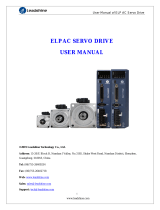 Leadshine ELP-D&RS User manual
Leadshine ELP-D&RS User manual
-
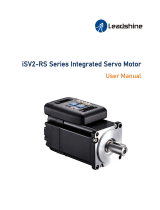 Leadshine iSV2-RS6020V48 User manual
Leadshine iSV2-RS6020V48 User manual
-
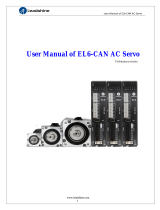 Leadshine EL6-CAN Series AC Servo Drive User manual
Leadshine EL6-CAN Series AC Servo Drive User manual
-
 Leadshine ELD2-CAN Series DC Servo Drive User manual
Leadshine ELD2-CAN Series DC Servo Drive User manual
-
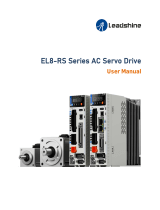 Leadshine EL8-RS Series AC Servo Drive User manual
Leadshine EL8-RS Series AC Servo Drive User manual
-
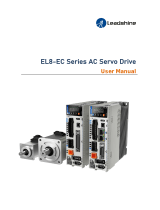 Leadshine EL8-EC Series AC Servo Drive User manual
Leadshine EL8-EC Series AC Servo Drive User manual
-
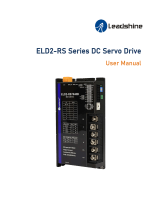 Leadshine ELD2-RS Series DC Servo Drive User manual
Leadshine ELD2-RS Series DC Servo Drive User manual
-
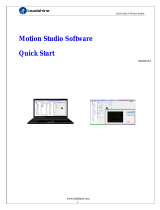 Leadshine Motion Studio Stepper Software Quick Start
Leadshine Motion Studio Stepper Software Quick Start
-
 Leadshine 2ELD2-CAN Series DC Servo Drive User manual
Leadshine 2ELD2-CAN Series DC Servo Drive User manual
-
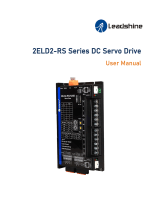 Leadshine 2ELD2-RS Series DC Servo Drive User manual
Leadshine 2ELD2-RS Series DC Servo Drive User manual
Other documents
-
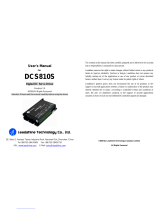 Leadshine Technology DCS810S User manual
Leadshine Technology DCS810S User manual
-
Fagor CNC 8065 for lathes Owner's manual
-
Delta Electronics ASDA-B2 series User manual
-
Sanyo SUPER BL P5 User manual
-
Delta Electronics ASDA-B User manual
-
Delta Electronics ASD-B1021-A User manual
-
Mitsubishi Electric MR-E-_A-QW003/AG-QW003 User manual
-
Mitsubishi Electric MR-E-_A-KH003/AG-KH003 User manual
-
Delta Electronics ASD-A1021-AB User manual
-
Mitsubishi Electric MR-J3- A User manual















































































































































































